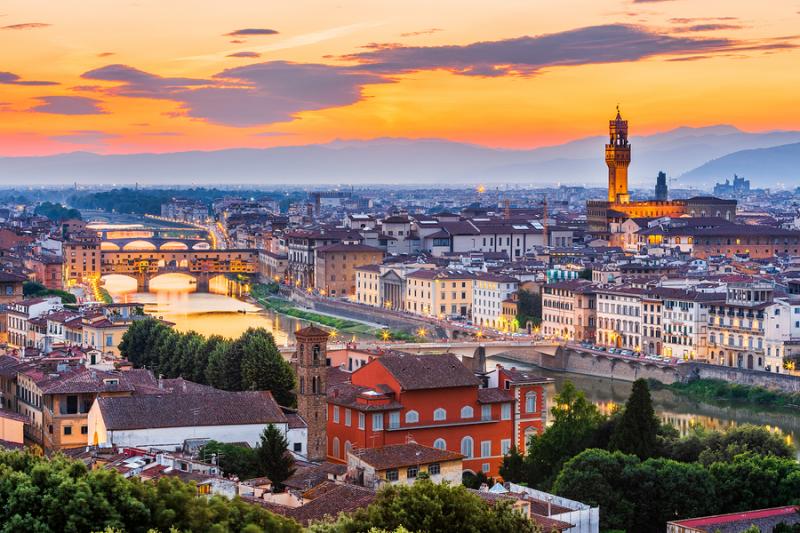Unesco Sites of Italy: Florence
ITA:

Use player to listen to Italian version
Inscribed on the Unesco World Heritage List since 1982, the historic center of Florence is defined as a “unique artistic realization, an absolute chef-d’œuvre, the fruit of continuous creation over more than six centuries.”
In addition to its numerous museums, with the Uffizi Gallery renowned for being the oldest museum of modern Europe, Florence boasts the greatest concentration of universally renowned works of art, including the Cathedral of Santa Maria del Fiore, the Baptistery and the Campanile of Giotto, Piazza della Signoria with Palazzo Vecchio and the Uffizi Gallery, San Lorenzo, Santa Maria Novella, Santa Croce and the Pazzi chapel, Santo Spirito, San Miniato, and the Convent of San Marco, with paintings by Fra Angelico. In addition, Florence has preserved well its ancient streets, fortified buildings, loggias, fountains, the magnificent Ponte Vecchio, Renaissance palaces, and much more.
However, it’s not just the incredible monuments of Florence to grant it Unesco status; since the 15th century, the city “has exerted a predominant influence on the development of architecture and the monumental arts – first in Italy, and throughout Europe.” It was in Florence that the artistic principles of the Renaissance were defined, thanks to artists of the caliber of Brunelleschi, Donatello and Masaccio. And it was in Florence that two universal geniuses of the arts – Leonardo da Vinci and Michelangelo – trained and established themselves as the greatest artists of their time.
Beyond the artistic realm, Florence was, between the 14th and 17th centuries, a major economic and political power in Europe, playing a role in events of international importance, including the development of the Renaissance.
Strolling through the alleys of its historic center, you can almost picture the intense life of the community, merchants, artisans, and artists going about their business, as well as the secrets and plots of political and civil power.
Inserito nella lista del patrimonio mondiale Unesco dal 1982, il centro storico di Firenze è definito come “una realizzazione artistica unica, un capolavoro assoluto, il frutto di una creazione continua durata sei secoli”.
Oltre ai suoi numerosi musei, con la Galleria degli Uffizi rinomata per essere il più antico museo dell'Europa moderna, Firenze vanta la più grande concentrazione di opere d'arte di fama mondiale, tra cui la Cattedrale di Santa Maria del Fiore, il Battistero e il Campanile di Giotto, Piazza della Signoria con Palazzo Vecchio e la Galleria degli Uffizi, San Lorenzo, Santa Maria Novella, Santa Croce e la cappella dei Pazzi, Santo Spirito, San Miniato e il Convento di San Marco con dipinti di Fra Angelico. Inoltre, Firenze ha preservato bene le sue antiche strade, edifici fortificati, logge, fontane, il magnifico Ponte Vecchio, i palazzi rinascimentali e molto altro.
E non sono solo gli incredibili monumenti di Firenze a conferirgli lo status di sito Unesco; dal XV° secolo, la città “ha esercitato un'influenza predominante sullo sviluppo dell'architettura e delle arti monumentali - prima in Italia e poi in tutta Europa”. Fu a Firenze che furono definiti i principi artistici del Rinascimento, grazie ad artisti del calibro di Brunelleschi, Donatello e Masaccio. Ed è stato a Firenze che due geni universali dell'arte - Leonardo da Vinci e Michelangelo - si sono formati e si sono affermati come i più grandi artisti del loro tempo.
Oltre all’ambito artistico, Firenze è stata, tra il XIV° e il XVII° secolo, una importante potenza economica e politica in Europa, con un ruolo in eventi di importanza internazionale, incluso lo sviluppo del Rinascimento.
Passeggiando per i vicoli del suo centro storico, si può quasi immaginare l'intensa vita della comunità, i commercianti, gli artigiani e gli artisti impegnati nelle loro attività, così come i segreti e le trame ordite dal potere politico e civile.











